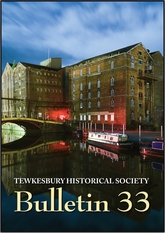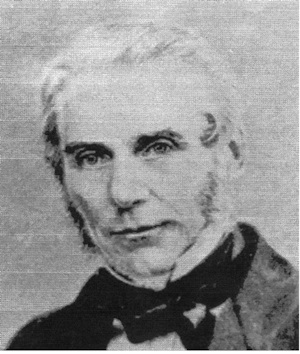Samuel Hitch, M.D. (1800-1881)
to Expand
Samuel Hitch was born in Stonehouse, Gloucestershire, in 1800 and educated at the University of Oxford. He then attended the best medical schools in England, France and Italy, before returning to Gloucester where, at the age of just 28, he took up the post of Resident Surgeon at the Gloucester County Lunatic Asylum, later known as Horton Road Psychiatric Hospital.
At the time of his appointment he was later described by Sir John Bucknill as, “an able, bustling, intelligent man, short in stature and with red hair”. He was a member of the Royal College of Surgeons and a Fellow of the Linnaean Society. It was not until 1840/41, however, that he was to take his M.D. degree to become a Member of the Royal College of Physicians and thus be appointed the first Superintendent and Resident Physician of Gloucester’s Asylum.
Just prior to his appointment in 1828, Samuel Hitch demonstrated his keen interest in psychological medicine when, in 1827, he took into his own home a seven-year old girl, the daughter of a local farmer. The case itself was later reported in Treatise on Insanity, a book, published in 1835, by James Cowles Pritchard. Such was Hitch’s reputation in the field of mental health at this time that Pritchard had written to him for advice and information on ‘Moral Insanity’, ‘General Paralysis of the Insane’ and the ‘Recovery rates in Asylums’.
In presenting the case Hitch describes the child’s behaviour in great detail and mentions the role-played in her care by his wife, Elizabeth. The young child apparently recovered in about two months and her case later became a classic and was often quoted as an example of ‘Moral Insanity’ throughout the mid to late nineteenth century.
The Gloucester Journal reported that, on 15 October 1836, the first ever balloon flight took place in Gloucester and the three men involved were Mr. Graham, Mr. Hitch and Mr. William Pugh. The balloon was filled with about 18,000 cubic feet of gas and was launched from the Quay.
Apparently it was a great occasion with the trio waving flags until they disappeared. The flight took about 25 minutes reaching about 12,000 feet and finally landed in a turnip field on Bredon Hill. Nobody was hurt, and the three returned to the city at about 8 p.m. that evening.Samuel Hitch quickly developed a reputation for his innovative care and treatment methods. The Asylum developed an excellent reputation and was reported to have the highest recovery rate in the country. It was Hitch who established the now common practice of giving his patients trial leave. An idea not supported in 1844 when the Commissioners in Lunacy reported that;
“At Gloucester the Superintending physician permits patients, before they are discharged, to go home to their own families and receives them again … without requiring fresh Orders and Certificates; and ten or twelve Pauper Lunatics appear to have ingress and egress from the asylum at all times at their own discretion. This practice is contrary to law…”
Elizabeth Hitch, Samuel’s wife, who was born in the City of Gloucester, was appointed Matron in 1838 at the age of 28. Later in 1841, in what may have been another first, a female attendant, the wife of a charge attendant, was employed on a male ward in order to encourage a gentler ward life. The idea was to be extended to other wards later.
Another remarkable innovation was the introduction of a ‘self governing’ group of patients. These 14 patients worked in the gardens and lived in a separate cottage on their own. The building was outside the asylum walls. These patients were under the supervision of the head gardener who lived at some distance from them and they were free to come and go as they so wished. They were able to cater for their own needs and to leave the Asylum grounds with the gardener’s permission.
Hitch was just as keen to adopt innovations and progressive ideas from other asylums. Following Dr. Conolly’s work on abolishing mechanical restraint, he visited Hanwell Asylum on the 6 April 1840 and, despite opposition from the Visiting Justices, he abandoned the use of restraint completely, though retaining the ‘Cold Bath’.
One report from a visiting doctor in 1841 stated that Samuel Hitch trusted his patients “to an extent not generally believed possible”. He always took the patients’ word and he allowed at least 20 per cent of his patients to be under no restrictions to their movements. They attended the church in town unescorted or in self-supporting groups.
It is in light of Samuel Hitch’s attitudes that he met with a few other medical men and as a result a letter was sent out to 26 asylums in England, seven in Scotland and the eleven in Ireland. (There were no Asylums in Wales at this time).
The letter dated 19 June 1841 suggested that medical men connected with asylums should be able to pool their knowledge and treatment ideas. His idea was to form an ‘Association’ of his fellow medical officer colleagues.
From this letter an inaugural meeting was held at Gloucester on 27 July and it is from this meeting that the Royal College of Psychiatrists was to be established.Samuel Hitch continued to introduce new ideas but from 1845 both he and his wife began to withdraw from the Asylum due it was said to their declining health. He intended to develop a private practice and in 1847 he retired completely from Gloucester and, with his wife, opened a ‘Licensed House for the Insane’ in the mansion of Sandywell Park near Cheltenham. The house is described in the Commissioners’ report of 1862 as being a large and handsome house, well maintained and catering for about 30 patients of the upper classes. The Commissioners were to report that they highly approved the practice of allowing about 15 or 16 patients of both sexes to dine together each day.
There is no evidence that the couple ever resided at Sandywell Park but we do know that he gave up the house in 1864 having passed on the licence to Dr. W. H. O. Sankey. He then retired completely to Southwick Park near Tewkesbury.[1]
Dr. Samuel Hitch was a man ahead of his time. Much of his work was lost to his successors and it was to be over a hundred years later that Psychiatrists reintroduced Hitch’s approaches to care and Mental Health.
References
- Gloucester’s Asylums 1794 – 2002. (An account of Gloucester’s two Public Mental Hospitals at Horton Road and Coney Hill). Author and Publisher: Ian Hollingsbee (I.S.B.N. 0-9543534-0-4).
- Gloucester and the Beginnings of the R.M.P.A. by A. Walk & D. Lindsay Walker. The Journal of Mental Science Vol. 107, No 449, June 1961.
Ian Hollingsbee trained as a psychiatric nurse before becoming a clinical teacher, tutor and, later, Senior Lecturer at the University of the West of England. He holds a Masters Degree in Gerontology and is a Gloucester Magistrate. He has also written several local history books. Ian lectured in October 2003 to the County Local History Forum on Mental Health, when his mention of the subject of the article struck a chord with the Editor as Samuel Hitch had appeared in our database.
Hitch was made a freeman of Tewkesbury in 1823 and was Mayor for three consecutive years after 1861. He was followed in 1864 by Dr. William Allard. [3] Because of this connection, Ian kindly agreed to write an article about this eminent physician.
- In the 1861 Census, then aged 62, he was living at Southwick Park with his wife. This residence was the Boys Grammar School from 1952 to 1972 after which it has been occupied by Severn Trent and Equinox. (Editor).
- This was recorded by the Tewkesbury Register, 29 September 1881. It also reported that he had left Southwick Park after the death of his wife and that he had married the widow of Arthur Shute; he also invested in the Hosiery factory, perhaps in East Street. (Editor).
- This, and other information appearing in the footnotes, is from the Woodard Database. (Editor).
- It is perhaps a coincidence that the first female Professor of Psychiatry, Beatrice Edgell, was born in Tewkesbury. See biography by Dr. Elizabeth Valentine in T.H.S. Bulletin No. 11 (2001), p27.



Comments